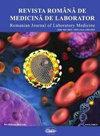COVID-19两种诊断方法的一致性:来自巴西临床实验室的初步数据
IF 0.5
4区 医学
Q4 MEDICINE, RESEARCH & EXPERIMENTAL
引用次数: 0
摘要
摘要目的:探讨有症状和无症状患者的实验室资料可能存在的差异。可用于新冠肺炎诊断和监测的方法有多种,因此本研究旨在评价诊断方法的积极一致性。方法:对有症状的患者在症状出现后第1 ~ 2周采集鼻、口腔黏膜拭子标本进行RT-PCR检测,7天后采集血样进行抗体检测。对于无症状的患者,仅进行抗体检测以确认感染。我们研究了有症状和无症状患者的特异性体液免疫反应,并分析了免疫层析和ELISA检测的阳性指数和kappa一致性。结果:大多数有症状的患者IgM和IgA检测均为RT-PCR阴性。有症状和无症状的患者均表现出IgM和IgA免疫球蛋白升高,有症状患者的IgM和IgA免疫球蛋白升高。免疫层析的阳性指数高于ELISA,两种方法检测IgM和IgA无kappa一致性。结论:有症状患者IgM和IgA水平高于无症状患者,提示抗体水平与病情严重程度相关。我们证实IgM和IgA检测结果不一致,并且与ELISA相比,免疫球蛋白的阳性指数更高。不同的动力学可能导致它们的检测变化。此外,在这些方法中,许多不同的病毒蛋白可以用作抗原,从而能够改变它们的敏感性和特异性。本文章由计算机程序翻译,如有差异,请以英文原文为准。
Agreement between two diagnostic methods for COVID-19: preliminary data from a Brazilian clinical laboratory
Abstract Objective: To investigate possible differences between laboratory profiles of symptomatic and asymptomatic patients. There are different of them available for COVID-19 diagnoses and surveillance, so this research was to evaluate the positive agreement the diagnostic methods. Methods: For symptomatic patients swab samples from nasal and oral mucosal were collected between first and second week after symptoms onset, to perform RT-PCR, blood samples were collected 7 days after to perform antibody detection test. For asymptomatic patients, only antibody detection was performed to confirm the infection. We investigated specific humoral immune response for symptomatic and asymptomatic patients and also analyzed the positivity index and kappa agreement between immunochromatographic and ELISA assays. Results: Most symptomatic patients presented negative RT-PCR with IgM and IgA detection. Symptomatic and asymptomatic patients have presented elevated IgM and IgA immunoglobulins, being this detection higher in symptomatic patients. The positivity index for immunochromatographic was higher than ELISA and there was no kappa agreement between IgM and IgA detection between these two methods. Conclusion: Symptomatic patients presented higher amounts of IgM and IgA than asymptomatic, suggesting a relation between antibody quantity and severity of disease. We verified no agreement between IgM and IgA detection, and observed higher positivity index for IMMUNO when compared to ELISA. The different kinetics may cause a variation in their detection. Also, many different virus proteins can be used as antigens in these methods, being able of altering their sensibility and specificity.
求助全文
通过发布文献求助,成功后即可免费获取论文全文。
去求助
来源期刊

Revista Romana De Medicina De Laborator
MEDICINE, RESEARCH & EXPERIMENTAL-
CiteScore
0.31
自引率
20.00%
发文量
43
审稿时长
>12 weeks
期刊介绍:
The aim of the journal is to publish new information that would lead to a better understanding of biological mechanisms of production of human diseases, their prevention and diagnosis as early as possible and to monitor therapy and the development of the health of patients
 求助内容:
求助内容: 应助结果提醒方式:
应助结果提醒方式:


